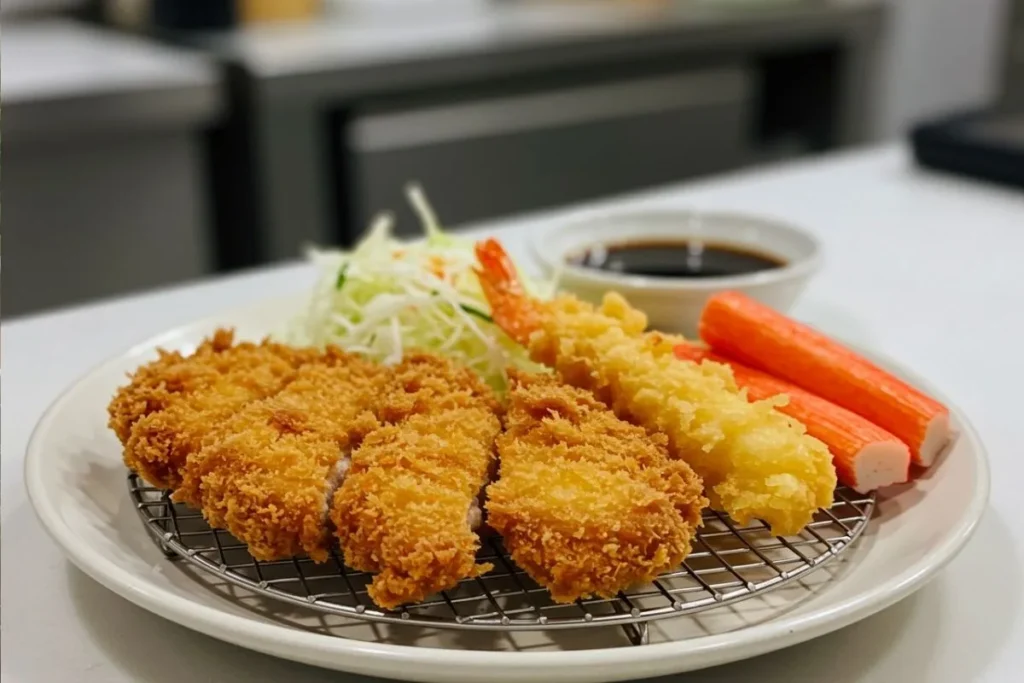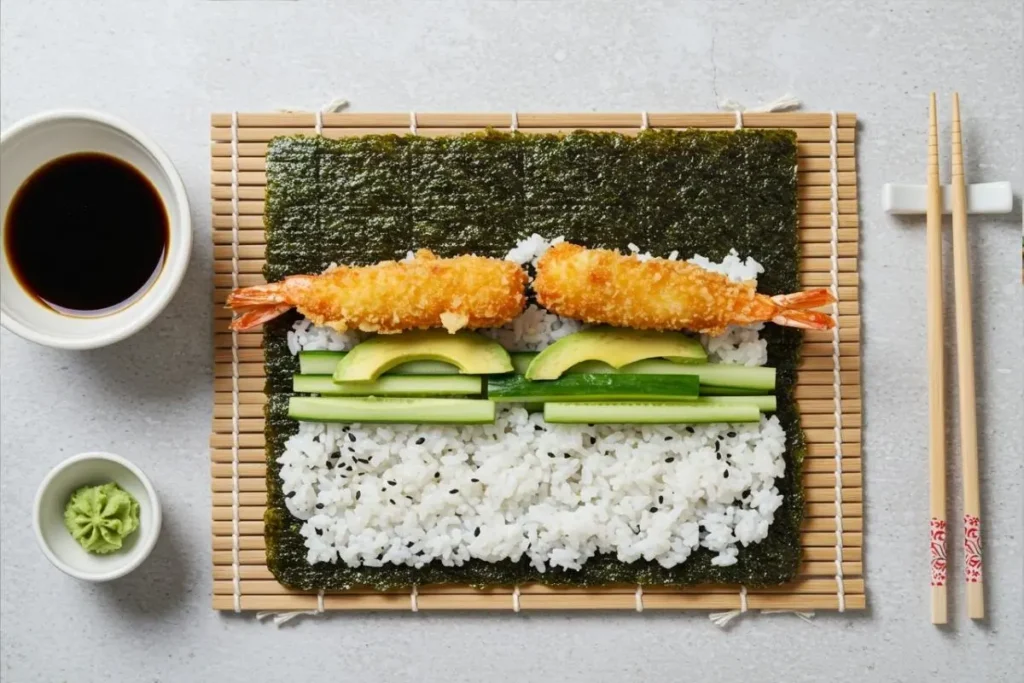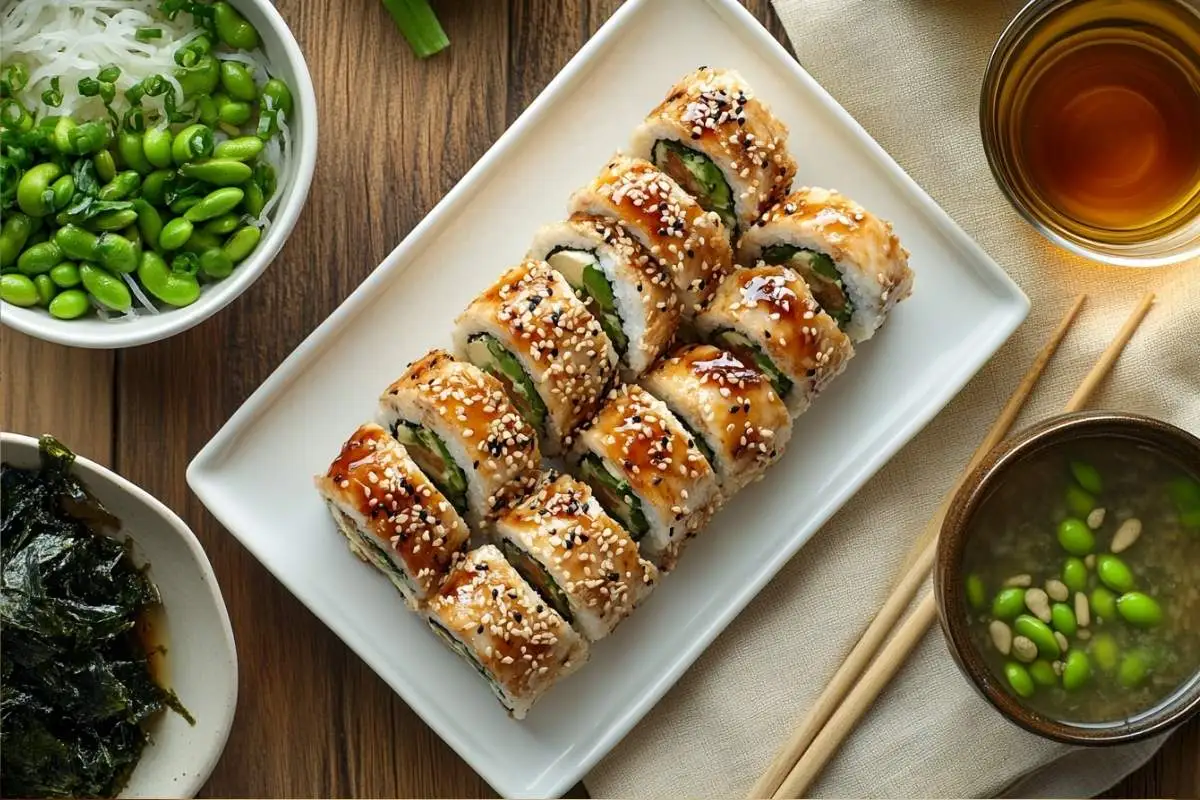Introduction
Tempura rolls are a modern twist on traditional sushi, offering a delightful blend of crisp textures and bold flavors. They’ve become a favorite for sushi enthusiasts who crave something more indulgent than standard rolls. But have you ever wondered what exactly goes into a tempura roll that makes it so special?
In this article, we’ll explore the essential components of a tempura roll, its origins, and the artistry involved in creating one. We’ll dive into the fillings, batter, and unique flavors that set this dish apart, as well as provide tips for making it at home. By the end, you’ll know everything about what makes a tempura roll both delicious and versatile.
Understanding Tempura Rolls
What is Tempura?
Tempura originated in Japan during the 16th century, brought by Portuguese missionaries who introduced the concept of frying food in batter. Over time, the Japanese adapted this technique, creating a light, crispy coating that perfectly complemented seafood and vegetables. Today, tempura is a staple in Japanese cuisine and is celebrated worldwide for its delicate texture and golden crunch.
What Does a Tempura Roll Have in It?
While tempura was traditionally served as a standalone dish, modern chefs began incorporating it into sushi rolls to create a fusion of flavors and textures. A tempura roll typically features crispy fried ingredients like shrimp or chicken, wrapped in seasoned sushi rice and nori. This innovative combination makes tempura rolls a popular choice, blending the best of traditional and contemporary culinary styles.
Tempura rolls are particularly appealing because they cater to a wide range of tastes. Whether filled with seafood, chicken, or vegetables, these rolls deliver an irresistible crunch with every bite. Additionally, their adaptability allows for endless variations, from spicy tempura rolls to vegetarian-friendly options.
By understanding its roots and evolution, you can better appreciate why tempura rolls have become a global favorite.
Essential Components of a Tempura Roll
What Ingredients Make Up a Tempura Roll?
Crafting the perfect tempura roll requires a harmonious blend of fresh ingredients and thoughtfully prepared elements. At its core, a tempura roll typically includes:
- Protein: Most tempura rolls feature lightly battered and fried shrimp, chicken, or even crab sticks for a crispy, flavorful base.
- Vegetables: Thinly sliced cucumber, avocado, or julienned carrots add freshness and balance.
- Nori: Seaweed sheets act as the outer wrapper, holding everything together while adding a subtle umami flavor.
- Seasoned Sushi Rice: Short-grain rice is seasoned with rice vinegar, sugar, and salt, providing a slightly tangy contrast to the tempura’s richness.

Optional Enhancements
To elevate the flavor and texture of your roll, you can include optional ingredients such as:
- Spicy Mayo: A creamy, spicy topping that enhances the roll’s flavor profile.
- Sesame Seeds: These add a nutty crunch and visual appeal.
- Tempura Flakes: Leftover bits of fried batter sprinkled on top for extra crispiness.
How to Prepare Ingredients for a Tempura Roll
- Use fresh, high-quality produce to ensure the best taste.
- For the batter, aim for a light, airy consistency by using ice-cold water and avoiding overmixing.
For an in-depth look at tempura preparation, check out our Chicken Tempura Roll Recipe, which offers step-by-step guidance on achieving the perfect crunch.
How a Tempura Roll is Made
Preparing the Ingredients
Before assembling the roll, ensure each component is properly prepared:
- Cook the Sushi Rice: Rinse the rice thoroughly to remove excess starch, then cook according to package instructions. Mix in rice vinegar, sugar, and salt while the rice is warm to enhance its flavor.
- Prepare the Protein: Coat the shrimp, chicken, or vegetables in tempura batter and fry until golden brown. Drain on paper towels to remove excess oil.
- Slice the Vegetables: Thinly slice cucumbers, avocados, or other chosen fillings.
Steps to Roll a Tempura Roll Perfectly
Once the ingredients are ready, follow these steps to assemble your roll:
- Lay Out the Nori: Place a sheet of nori on a bamboo rolling mat, shiny side down.
- Spread the Rice: Evenly press a thin layer of rice across the nori, leaving about an inch at the top for sealing.
- Add Fillings: Arrange the tempura protein and sliced vegetables horizontally across the center.
- Roll and Seal: Use the mat to roll the nori tightly, applying gentle pressure to secure the fillings. Moisten the top edge with water to seal the roll.

Cutting and Serving
To begin with, use a sharp knife to cut the roll into bite-sized pieces. Additionally, clean the blade with a damp cloth between cuts to maintain a clean presentation. Finally, garnish with sesame seeds, spicy mayo, or tempura flakes for added flavor.
For more sushi-making inspiration, explore our guide on Crispy Chicken Tenders, which shares tips on achieving a perfect fry for various dishes.
Exploring Different Types of Tempura Rolls
Classic Tempura Rolls: What’s in Them?
Tempura rolls come in various forms, but some classics remain fan favorites:
- Shrimp Tempura Roll: This roll features crispy tempura shrimp paired with creamy avocado and crunchy cucumber for a perfect balance of textures.
- Chicken Tempura Roll: A great option for those who prefer meat over seafood, combining tender, crispy chicken with fresh vegetables.
- Vegetable Tempura Roll: Ideal for vegetarians, this version includes tempura-fried sweet potatoes, zucchini, or asparagus.
Regional and Creative Variations
Tempura rolls are also a canvas for culinary creativity, with regional influences adding unique twists:
- Spicy Tempura Roll: Incorporates sriracha or spicy mayo for a fiery kick.
- Dragon Tempura Roll: A visually stunning roll topped with avocado slices arranged to resemble dragon scales.
- Gluten-Free Tempura Roll: Uses gluten-free flour for the batter, catering to those with dietary restrictions.
When you’re ready to try making a twist on the classic roll, visit our Melt-in-Your-Mouth Chicken Recipe for more inspiration.
Health Aspects of Tempura Rolls
Nutritional Breakdown
Tempura rolls, like many sushi dishes, offer a balance of flavors and textures. However, understanding their nutritional content is important:
- Calories: On average, a tempura roll contains 350–450 calories, depending on its size and ingredients.
- Protein: Rolls with shrimp or chicken provide a good source of lean protein, typically 10–15 grams per serving.
- Fats: Tempura’s frying process adds fat, but opting for lighter oils can help reduce the overall fat content.
Healthier Preparation Tips
For those looking to make tempura rolls healthier without compromising flavor, consider using an air fryer to achieve a crispy texture with less oil. Choosing lean proteins like shrimp or chicken and reducing the amount of rice can also lower calorie content. To learn more about healthier cooking methods and tips, visit Healthline’s guide on the healthiest oils for deep frying.
- Use an Air Fryer: Air frying the tempura results in a crispy texture with less oil.
- Choose Lean Fillings: Opt for chicken breast or shrimp for a lower-calorie option.
- Limit Rice: Reducing the amount of rice in your roll can lower carbohydrate content.
Moderation and Balance
While tempura rolls are delicious, they’re best enjoyed in moderation due to the frying process. Pairing them with nutrient-dense sides like seaweed salad or miso soup adds balance to the meal.
To explore more ways to balance indulgence and nutrition, check out our Chicken Tempura Roll Recipe, where we break down the preparation process for this popular dish.
Frequently Asked Questions About Tempura Rolls
What Does Tempura Include?
Generally speaking, tempura refers to a light, crispy batter used to coat a variety of ingredients before frying. Typically, tempura includes flour, cold water, and egg to create a thin batter. In addition, ingredients commonly coated in tempura include shrimp, chicken, vegetables like zucchini or sweet potato, and even unique options like mushrooms or avocado.
When applied to sushi rolls, tempura often transforms the primary filling into a crispy, savory delight, elevating the overall texture and flavor.
What Is Most Common in Tempura Rolls?
The most popular tempura rolls often feature shrimp or chicken as the central protein. Vegetables like cucumber, avocado, or carrots are also common fillings. Additionally, condiments like spicy mayo, soy sauce, or eel sauce enhance the flavor of these rolls.
For those seeking variety, dragon rolls or spicy tempura rolls add visual flair and bold flavors, making them top picks at sushi restaurants.
Is Tempura Sushi Unhealthy?
Tempura sushi is not inherently unhealthy, but it’s important to consider portion sizes and preparation methods. The frying process does add calories and fat, but choosing lean proteins like shrimp or chicken tempura can balance the meal.
Additionally, pairing tempura rolls with lighter side dishes, such as steamed edamame or miso soup, can make the overall meal more nutritious.
Are All Tempura Rolls Cooked?
Yes, all tempura rolls feature cooked ingredients since the tempura batter is fried. This makes them an excellent option for diners who prefer cooked sushi over raw fish. For example, chicken and shrimp tempura rolls are fully cooked, offering a safe and delicious choice for sushi newcomers.
Pairing Ideas and Creative Variations for Tempura Rolls
Perfect Pairings for Your Tempura Roll Meal
To elevate your tempura roll meal, consider these side dishes:
- Miso Soup: A savory soup that complements the crispy texture of tempura rolls.
- Edamame: Steamed soybeans provide a nutritious, crunchy side.
- Seaweed Salad: A refreshing option that balances the richness of tempura rolls.
Adding these sides ensures the meal feels complete and satisfying, no matter the occasion.
Creative Tempura Roll Variations
Tempura rolls offer endless room for creativity. Here are a few ideas to try:
- Spicy Tempura Roll: Add sriracha mayo or chili flakes to the filling for a fiery kick.
- Rainbow Tempura Roll: Top your roll with a colorful assortment of fresh fish slices for a vibrant presentation.
- Vegetarian Tempura Roll: Replace proteins with tempura-fried vegetables like eggplant or sweet potatoes.
These variations make tempura rolls versatile enough to suit any taste preference or dietary need, ensuring they remain a favorite for both casual dinners and special occasions. For those looking to try something new, consider a gluten-free tempura roll by using gluten-free flour for the batter. You can also create a low-carb version by using zucchini noodles or cauliflower rice. Looking for broader tips on maintaining a healthy diet? Visit Mayo Clinic’s guide to healthy eating for inspiration.
Tips for Perfecting Your Tempura Roll
Mastering the Art of Tempura Batter
The key to a perfect tempura roll starts with the batter. To achieve the signature light and crispy texture:
- Keep the Batter Cold: Use ice-cold water to mix the batter. The temperature prevents gluten formation, ensuring a delicate crunch.
- Avoid Overmixing: Stir the ingredients gently. A few lumps are fine and can even improve the crispiness of the batter.
- Use Fresh Oil: Old oil affects both flavor and texture, so always opt for clean, high-quality oil.
Perfecting the Rolling Technique
Creating the perfect roll requires precision, but it’s simpler than it seems:
- Spread the Rice Evenly: Press the seasoned sushi rice onto the nori in a thin, consistent layer.
- Don’t Overfill: Too many ingredients can make the roll difficult to seal. Keep the filling proportionate for easy rolling.
- Seal It Tight: Moisten the top edge of the nori with water to ensure the roll stays closed.
Pro Tip: Use a sharp knife to slice the roll into even pieces. Clean the blade after each cut for a polished presentation.
Common Mistakes to Avoid
Even experienced cooks can encounter challenges when making tempura rolls. Here’s how to sidestep the most common pitfalls:
- Soggy Nori: Assemble the rolls just before serving to keep the seaweed crisp.
- Oil Temperature Issues: If the oil is too hot, the batter will burn before the chicken cooks. Conversely, low temperatures result in greasy tempura.
- Thick Batter: A heavy batter can overpower the delicate balance of flavors in the roll. Aim for a thin, even coating.
By mastering these tips, you’ll create rolls that not only taste incredible but also look restaurant-quality.
Why Tempura Rolls Are a Must-Try
Undeniably, tempura rolls offer a delightful blend of textures and flavors, making them a standout option for sushi lovers. With their crispy tempura coating, seasoned rice, and fresh fillings, these rolls consistently deliver a satisfying bite that appeals to a wide range of tastes.
A Versatile and Crowd-Pleasing Choice
Whether you’re new to sushi or a seasoned enthusiast, tempura rolls provide an approachable and delicious option. Their adaptability allows you to tailor the recipe to your preferences—think spicy mayo, unique fillings, or creative toppings like sesame seeds or tempura flakes.
In addition, tempura rolls are ideal for any occasion, from a casual family dinner to an elegant gathering with friends. Pair them with sides like miso soup or edamame to round out the meal, creating a complete dining experience.
The Joy of Making Tempura Rolls at Home
Crafting tempura rolls at home isn’t just a recipe; it’s an enjoyable and rewarding experience. The process of frying tempura, rolling sushi, and perfecting the final presentation is both satisfying and fun. Moreover, it’s a fantastic way to involve loved ones in the kitchen, turning meal prep into a shared activity.
There’s absolutely no need to wait for a special occasion to enjoy these rolls. With that in mind, using simple ingredients and following clear steps, you can easily recreate this restaurant favorite in the comfort of your home. Additionally, the sense of accomplishment from making your own sushi is unmatched.
Therefore, why not gather your ingredients and try it today? From the crispy crunch of tempura to the vibrant flavors of fresh fillings, tempura rolls promise a memorable culinary adventure. Ultimately, dive in and discover why this dish remains a favorite among sushi lovers worldwide!

